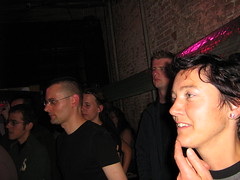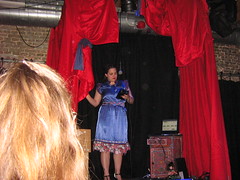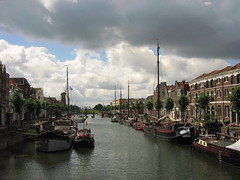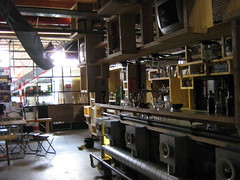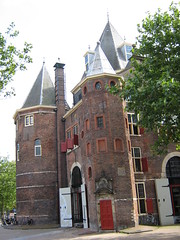Having caught up everything about the graduation show, now I’ll get to the meeting I had this morning, with Hajo Doorn, director of Worm. I’ll start by saying that of all the meetings and conversations I’ve had about how different institutions work here in the Netherlands, this was by far the best. In addition to offering me a wealth of information, Hajo let me really see inside Worm, as if I wasn’t some random person dropping by, but somehow part of things. I’ll explain that a little better later, but let me go in order.
Worm really is unique–of course every place wants to think that, but usually it’s not true. In this case though, I can’t think of any other cultural or arts organization I’ve ever seen that runs exactly like Worm. First of all, the range of activities is amazingly broad. Events held there include dance parties, film screenings, live bands, sound art installations, electronic/computer art installations, lectures, and educational activities like the recent Piet Zwart graduation. Worm also stands out because of the way they balance their growing role in the community, which gives them more chance at funding and at shaping the local conversation about art and culture in Rotterdam, with still maintaining the freedom of an outsider to take risks and to do things a little differently. That last is no small feat when dealing with civil servants and funding agencies. Finally, Worm is focused on people, inside the organization and those they collaborate with or invite in, rather than on their own institutional status.
This last characteristic was what Hajo most emphasized. But before I expand that point let me back up a bit and first say something about Hajos’ take on the whole scene. The Netherlands is a small country, so it’s not so hard for a group to get started and get some attention. They all compete with each other, which Hajo thinks is productive because it draws more attention to the scene as a whole. But, established institutions try to claim the discourse, which shuts out groups; this means they have to work hard to find a niche and show how they are different. Taking V2 as a contrast for example, according to Hajo, “V2 is big in their scene, but it’s very small scene.” He also commented on how they were not very connected to the local community, or to the open source community. I had noticed the latter when talking to Alex and everyone seems to recognized the V2 is very narrowly focused, the only question is whether they think the narrow focus is a deliberate strategy, or something that dooms V2 to shrinking relevance. Other organizations also seem far more hierarchical; both V2 and de Waag have a clear and seemingly rigid hierarchy with the people on top exerting very firm control over everyone else and having set guidelines for how they do everything. I’d say de Waag is not as rigid as V2, and maybe they need more structure since they have so many community stakeholders.
But Hajo and the others at Worm take it as a principle that they “design for people, not for systems,” which means they have often asked their funding organizations or the civil servants they work with if they really want this kind of report or that kind of procedure, because it will cost so many thousands of Euros to produce. Often, the answer is no, and they find a different way to provide what the funding agency or civil servants need. In fact, while the other organizations I visited explained their goals and criteria, which were all about art, culture, and sometimes the community, I didn’t get as clear a statement from them on their operating principles. Worm has several worth listing here:
- Energy is the most important quality [of a work or project]
- It’s all about people
- Let’s not pollute
- Design for people, not for systems
- Challenge the system
- Try to pay people, even a little
But they try to challenge with a smile, not in a nagging way. Also, note that the Netherlands has worked for a long time with the “polder” model of consensus, which is very different from the way government works in most other countries. Because just about the entire country is below sea-level, and because so much of it is made of reclaimed land, or polders, people had to agree on managing the dikes–at least that’s one story. Regardless of its origin, the polder model basically means that all stakeholders consult and cooperate, even if they are competitors. In the case of arts/cultural groups this has pros and cons. On the one hand, it encourages collaboration and sharing resources, but it also means that no one group can get very much money, so it’s hard for groups to grow beyond a certain point or become international.
In fact, Hajo wasn’t too concerned about this. He thinks that art should be local, and also he’s really into a do-it-yourself (DIY) approach, which doesn’t require huge chunks of money and isn’t really consistent with international ambitions. Because he’s always trying to do a lot with a little, Worm uses Linux running on computers that were salvaged, and Worms physical space is made with 80% recycled materials, mostly industrial salvage from the port (of Rotterdam). Along with the Polder model, the Rotterdam context is also very “flat” compared to other cities in the Netherlands, meaning that it’s pretty easy to get access to officials, which helps groups to get started.
Hajo shared a lot of other information–it was a three-hour meeting, including coffee and the chance to listen in as he talked over the success of the Piet Zwart graduation show with Florian (who was there with students making official documentation) and as he talked about possible future collaborations, plans for the building, how to spend out the remaining budget–I’ve never seen another group be so casual, except maybe my own department–maybe that’s why it was so comfortable. Anyway, I’ll post more tomorrow because it’s getting late!

